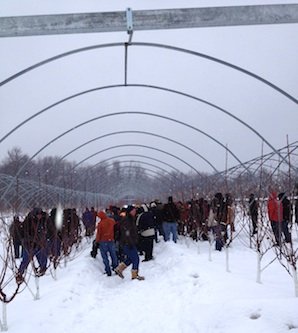The International Fruit Tree Association kicked off its 56th annual conference with a preconference intensive workshop focusing on apple fruit set—and how to effectively thin apples.
After experiencing extensive freeze damage last spring, growers in New York, Michigan, Ontario, and North Carolina are anticipating snowball bloom on well-rested trees laden with flower buds and will need to thin hard. While growers certainly want a sizable crop after a short-crop year, they need to avoid throwing their orchards into a biennial bearing mode.
Speakers at the workshop, held Saturday, February 23, at the Marriott Copley Place in Boston, hit the topic from every angle: Thinning at bloom with chemicals and mechanically with the Darwin string thinner; thinning during the best thinning window with chemicals including MaxCel (6-BA), NAA (naphthaleneacetic acid), NAD (napthaleneacetamide), and carbaryl; and late-season rescue thinning with Ethrel (ethephon).
Cornell University’s Dr. Terence Robinson reviewed the status of the carbohydrate model for predicting thinners’ effects. Growers in Michigan, New York, Pennsylvania, and other states can use the model—if they have access to good data loggers that accurately measure temperature and light intensity. Many data loggers are “junk,” he said, and growers who use bad data will have trouble.
University of Massachusetts pomologist Dr. Duane Greene reviewed his fruitlet model that can tell, usually within five to seven days after a thinner is applied, which apples will fall off and which will set. The key is measuring growth rate of individual fruits. Those that fail to grow at least half as fast as the fastest growing fruits will fall off.
Growers at the workshop heard from Louis Cournoyer, an apple grower from Rougemont, Quebec, who has used the Darwin string thinner for three years—with good success and no fireblight.
Nobody is entertaining the thought that 2013 could bring more freezes and a repeat of 2012, but they listened closely to North Carolina State University’s Dr. Steve McArtney, who reported on his work using sprays of Promalin on apples the morning after killing freezes. Nearly a third of a full crop of apples, perfectly formed but many without seeds, developed from the frozen blossoms. He reported his work in an article in the February 1, 2013, issue of Good Fruit Grower.
Sweet cherry and peach tree pruning demonstrations were held during a blizzard Sunday, February 24. Three pruning experts—Oregon State University’s Dr. Lynn Long, Michigan State University’s Dr. Greg Lang, and Penn State University’s Dr. Jim Schupp—tackled the trees in the Northboro, Massachusetts, orchard of Maurice Tougas and his partner-son Andre. They are direct marketers who sell fruit from about 80 acres of apples, peaches, and sweet cherries each year, with 95 percent sold you-pick. Their primary goal is to produce high yields in a pedestrian orchard.
Good Fruit Grower will take a closer look at apple thinning in the March 15 issue.


Leave A Comment